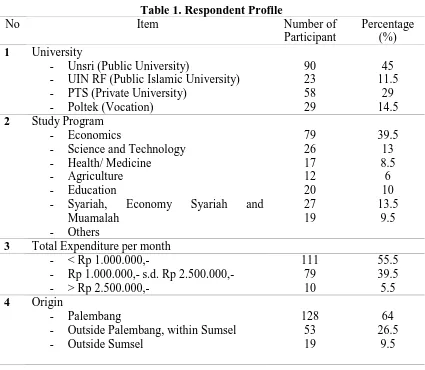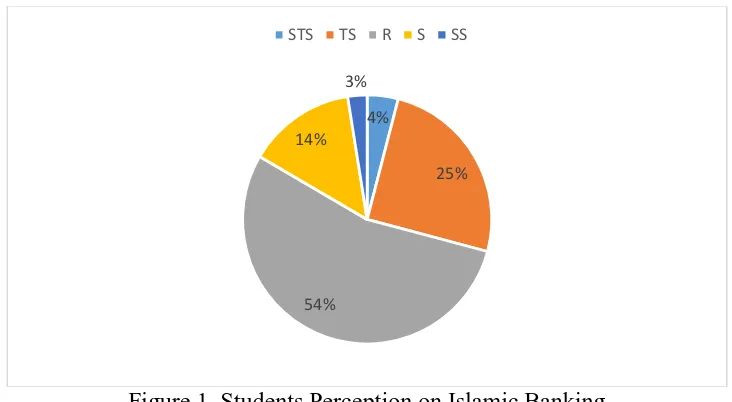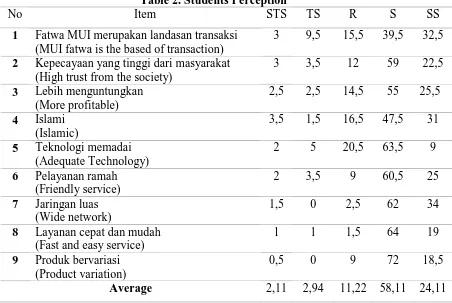STUDENTS’ UNDERSTANDING OF RIBA AND DETERMINING
FACTORS THAT PATRONIZE ISLAMIC BANKING IN
PALEMBANG
Mu‟izzudin1)
Fida Muthia2)
1)2)
Economic Faculty of Sriwijaya University
ABSTRACT
We try to find out students‟ understanding of riba and their determining
factors that patronize Islamic banking in Palembang. We surveyed 200 university students and found that they have a good understanding of riba, however, this fact does not induce high market share of Islamic banking in Palembang. We find that the network and widely spread ATM are the main reasons of why conventional banks are still the main option for students in making financial decision. This give implications that managers of Islamic banking should improve their service in order to enhance their market share.
INTRODUCTION
Indonesia is a country with the biggest Muslim population in the world with a total of 207,176,162 people or 87.18% (CBS, 2010). However, this potential does not make Indonesia as a superior country in implementing Islamic economics. Indonesia is only placed 10th by the Global Economy Indicator that consist of implementation criteria based on halal food, Islamic finance, travel, clothing, media and recreation, and medicines and cosmetics (GIE, 2015).
In terms of Islamic finance, formal implementation of Islamic economics in Indonesia begins with the emergence of an Islamic financial institution BaitutTamwil-Salman in Bandung and RidhoGusti Cooperative in Jakarta in the 1980s. The first Islamic bank in Indonesia was established in the end of 1992. The development in Islamic banking is becoming rapid as Bank Indonesia allows conventional bank to open its Islamic branches. This enables the bank to offer Islamic banking products and services that are separated from its conventional entity. Furthermore, Islamic banks also use Shariah compliance in their transaction; for example, they use profit sharing instead of bank interest for their customers. Currently, there are 12 Islamic Banks (BUS), 22 Sharia Units (UUS), 90 Financing Bank Sharia (BPRS) and 2732 Islamic bank offices spread throughout Indonesia (SPS, 2015).Furthermore, the total assets of Islamic bank is quite high up to Rp. 200217 billion (BUS) and USD 73277 billion (ibid.)
Despite the rapid development, the market share of Islamic banking is still at 4.88% (FSA, 2015), it would be an evaluation for all parties that the existence of Islamic banking as an alternative has not become the choice with a majority of Muslim population even though the Muslim Council Indonesia (MUI) has issued a fatwa of bank interest since 2004.The council states that bank interest is considered as
riba. It refers to “an unjustified increment in borrowing or lending money, paid in
kind or in money above the amount of loan, as a condition imposed by the lender or
584 ISBN 979-587-563-9
matter, it is reasonable to assume that Muslims tend to use facilities from Islamic banking, hence, increasing its market share. Surprisingly, such assumption does not hold in Indonesia, as many Muslims still prefer to be conventional bank customers.
This may be caused by the lack of understanding of the community on the differences between the practice implemented by both conventional and Islamic banks, that there are no distinct differences between them (Mahardika, 2005 in Adam and Muizzudin, 2015). Karistianto (2013) states that there at least three reasons of why the target market is low. Firstly, there is a lack of public awareness on Islamic bank. Secondly, the infrastructure and the quality of Islamic bank are significantly less than those of conventional bank and lastly, conventional bank has non-technical advantages compared to Islamic bank. All these factors lead to disadvantages bore by Islamic banks, as they cannot meet broader demand on both conventional and Islamic services.
Therefore, it is important to examine of why community still uses conventional banks over Islamic banks. Several studies have investigated customer perception on Islamic banking. Abiah and Kundi (2012) surveyed 134 respondents in Negeria on their perception of Islamic banking and they found that there is still a misconception on Islamic banks, in which some believe that these banks are only for Muslims. They also state that young and educated people are more familiar with Islamic banks. This is similar to the findings of Ariani (2007) that states education, age and service has
significant effect on people‟s perception of Islamic banking. However, Karistianto (2013) argues that supply-side problems such as services as stated by Ariani (2007) is not the reason of why people choose conventional banks over Islamic banks. He states that conventional banks have early-mover advantage and there are a lot of Muslims that are still unaware of its existence. Saad and Mubasshera (2015) support this finding and mention that familiarity of the bank is the reason why people still use conventional banks.
Furthermore, some studies also investigate whether people‟s understanding of riba affects their preference in Islamic banking. Two distinct findings come from two countries that have high Muslim population: in Pakistan, many people are still unaware on the concept of riba, which leads to their misconception on Islamic Banks (Hassan, 2007). Meanwhile, in Malaysia, people have a good understanding of riba but choose to conventional bank due its familiarity. Therefore, our study also focuses on investigating whether people in Indonesia especially in Palembang have good understanding of the concept of riba.
This study will use methodology proposed by Saad and Mubasshera (2015) through questionnaires. As many studies prove that the level of education affects
people‟s perception on Islamic banking, we limit our study objects only on university students in Palembang. We believe that student understanding on Islamic banking is potential for the development of Islamic banking in Indonesia. We also assume that students have involve in financial decision in their daily lives such as, decision in using banking services, therefore, it is also essential to examine their perception.
Our study makes several contributions. First, it will extend the literature by providing the determinants on people preferences of conventional banks. Second, this
study establishes a good overview on people‟s understanding of riba. This will give
insights for government and Islamic banks manager on how to increase their market share in Indonesia.
LITERATURE REVIEW
Perception and Behavioral Finance
Perception is one of physiological aspects that is essential to respond other aspects in human life. Perception has wide definition both internal and external. Walgito (2004) states that percepion is a process of organizing, interpreting the stimuli received by an organism or an individual and is an integrated activity of an individu. This will also affect an individual behaviour on the existance of islamic banking.
Shefrin defines behaviour finance is a study of how physcological phenomenon affects an individual financial behaviour. While Nofsinger (2001) studies how human act in a financial setting. The development of study on behavioural finance is started by Solvic (1969 and 1972) that find physcological aspect on investment and stockbroker (Manurung, 2012). In 1974, Treversky and Kahneman describe an evaluation on how uncertainty can create bias. The study proceeds on many researchers investigate the topics on behavioural finance (Stateman, 1995; Golber and Nitzsch, 1999; and Forbes, 2009 as cited in Manurung, 2012).
Islamic Banking Perception
Many studies have investigate people‟s perception towards Islamic Banking.
Abdiah and Kundi (2012) surveyed 134 respondents in Nigeria on their perception towards Islamic Banking and they find that most of the respondents have misconception on Islamic Banking. This may be due to the fact that majority of their respondents are christians (63%) that have no background knowledge on Shariah law and Islamic Banking specifically. Another study is conducted in Pakistan that have high Muslim population but the result shows that many people are still unaware about the concept of riba (Hassan, 2007). This study also mentions that many customers are still not confidence about the operational matters on Islamic Banking.
Furthermore, Kariastanto (2013) tries to explain the reason why Indonesia still has a small share of Islamic Bank despite having the highest number of Muslim population. The study finds that non-technical factors such as early-mover advantage and lack of Muslims awarness are may be the cause of such small percentage of Islamic Banking share in Indonesia. As Islamic banks have just established in 1992 in Indonesia, people are more familiar with the services provided by conventional banks and many Muslims believe that the systems and services offered by conventional and islamic banks are the same. This study is also supported by Saad and Mubasshera (2015) that examine Malaysian preference on Islamic banking. They state that people choose conventional banks because they are more familiar with the services provided. The study also proceeds on finding whether people understand the concept of riba and they suggest that Malaysian gave a good understanding of riba and this religious aspect is not the reason why they choose to stay in conventional banks. Furthermore, the findings also indicate that academicians among other profession have the highest understanding on riba and perception on islamic bank. This is similar to those find by Ariani (2007), that points out education, age and service has significant effect on the preception towards Islamic banks.
METHODOLOGY
586 ISBN 979-587-563-9
Sample
The total of 200 respondents are selected from various faculties and universities. We narrow our study by only examining the perception of Muslim students in Palembang. Therefore, our respondents are Muslim students in Palembang that has bank account on conventional bank, islamic bank or both.
Data Collection Method
The data for this study is obtained through questionairres in which we divided into three sections. The first section will include demographic information of the respondents. In the second section, we list statements with regards to their choices in financial decision such as in deciding the bank account. Finally, in the third section, we ask their understanding on the concept of riba.
RESULTS AND DISCUSSION
- UIN RF (Public Islamic University)
- PTS (Private University)
3 Total Expenditure per month
expenditure of less than Rp. 1.000.000 per month (55.5%) and most of them come from Palembang (64%).
The understanding of riba
Riba is one of the aspects that differentiate Islamic and conventional financial institution. However, there are many misperceptions that assume riba is not crucial in Islam. Our findings show that students in Palembang have a good understanding in riba and that they are aware if riba is forbidden in Islam. This is conflicting with the fact that the low market shares of Islamic banking. This may be caused by the trade- off between understanding and application. The trade off is caused by factors such as product knowledge or the lack of Islamic banking literate. Our respondents profile shows that the students of UINRaden Fatah has better understanding that other universities.
Conventional Bank vs Islamic Bank
Our findings show that people‟s understanding on conventional bank and
Islamic bank is balanced. However, in term of convenience, efficiency, product variations, advancement and high return, conventional bank is seen to be better than Islamic banks. This is similar to the case in Pakistan, that people are still not confidence with the operational matters of the Islamic Banking (Hassan, 2007). Furthermore, it should be highlighted that the „unsure‟ option has high percentage
indicating that the people‟s understanding for product knowledge is still low.
Good understanding on the difference between conventional and Islamic bank is needed as misperception on Islamic bank can lead toa low market share (Mahardika, 2005). The general public assumption is that there is no difference between the practice of conventional and Islamic bank. This study proves that 54% of respondents are still unsure on the difference that it can be defined as confusion (Figure 1.).
Figure 1. Students Perception on Islamic Banking
The misperception indicates the uneven information spread of Islamic banks. Society is yet to have a good understanding on Islamic banking, its system, type of
product and its advantageous over conventional banks. Table 2 shows that students‟
perception on Islamic banking is positive.
4%
25%
54% 14%
3%
588 ISBN 979-587-563-9
Table 2. Students Perception
No Item STS TS R S SS
1 Fatwa MUI merupakan landasan transaksi
(MUI fatwa is the based of transaction)
3 9,5 15,5 39,5 32,5
2 Kepecayaan yang tinggi dari masyarakat
(High trust from the society)
8 Layanan cepat dan mudah
(Fast and easy service) implementation. Positive perception is potential for treatment to influence the market as a whole.
Furthermore, our results show that there is a difference between perception and attitude that determine in transaction decision. Even though there is a good understanding of riba and students perception on Islamic banking is reasonable, this does not indicate that Islamic banking becomes the first choice on the financial decision. Our findings are able to explain the reason of why students still using conventional banks. Wide network and easily accessed ATM stations are found to be the main reason of these differences.
CONCLUSION, LIMITATION AND SUGGESTION
Our results show that the level of understanding on riba is good and there is a positive perception on Islamic banking. However, this is not a determining factor on financial transaction. The most dominant factors that affecting the transaction decision on conventional banks are network and wide ATM spread.
Our study has some limitations, such as, sampling bias that may influence the measurement error and study setting that is still lacking. Therefore, it is suggested that
further study to use larger sample and include variable „religion‟ in the study like the
REFERENCES
Adam, Mohamad dan Muizzuddin. 2015. “Islamic Value and Profile serta Financial
Literacy Karyawan Bank Syariah di Palembang”, Prosiding 1st
World Islamic Social Science Congress, Universiti Sultan Zainal Abidin, Kuala Terengganu, Malaysia.
Ascarya. 2009. “Toward Optimum Synergy of Monetary Policy in Dual Financial/
Banking System”. Journal of Indonesian Economy and Business, Vol.24, No.1
Ariani, Dian. 2007. Persepsi Masyarakat Umum terhadap Bank Syariah. Tesis. Sekolah Pascasarjana Universitas Sumatera Utara
Ascarya dan Yumanita, Diana. 2005. Bank Syariah : Gambaran Umum. Pusat Pendidikan dan Studi Kebanksentralan (PPSK) Bank Indonesia. Jakarta : Bank Indonesia
Antonio, Muhammad Syafii. 2001. Bank Syari‟ahdariteorikePraktik. Jakarta:
GemaInsaniPers&TazkiaInstitut
Departemen Agama Republik Indonesia. 2005. Al-Qur‟an Terjemahan. Jakarta : PT. Syamil Cipta Media
Dewan Penerjemah Al-Qur‟an. 1413H. Al-Qur‟an dan terjemahnya. Madinah : Komplek Percetakan Al-Qur‟an Raja fahd
Ghazaly, Abdul Rahman, dkk. 2010. Fiqh Muamalat . Jakarta : Kencana Prenada Media
Hassan, MehboobUl. 2007. “People Perception‟s toward Islamic Bank ; A Field Work Study on Bank Account Holder Behavior in Pakistan”.
Kodun Abiah, Fada dan Wabekwa, Kundi. “People‟s Perception Towards Islamic
Banking: A Field work study in Gombe Local Government Area, Nigeria”,
International Journal of Business, Humanities and Technology Vol. 2 No. 7; December 2012
Krishna, A, Rofaida, R. & Sari, M. “Analisis tingkat literasi keuangan di kalangan
mahasiswa dan faktor-faktor yang mempengaruhinya (Survey pada Mahasiswa
Universitas Pendidikan Indonesia)”. Proceedings of The 4th International Conference
on Teacher Education, Join Conference UPI & UPSI Bandung, Indonesia, 8-10 November 2010
Kariastanto, Bayu. “Small Share of the Islamic Banks in Indonesia, Supply-side
Problems?”. MPRA Paper No. 61248(2013). Accessed Oktober 14, 2015. http://mpra.ub.uni-muenchen.de/61248/
590 ISBN 979-587-563-9
Nofsinger, John R. 2001. “Individual Investors in Japan: Tests of Overconfidence,”
Financial Management Association October, Toronto, Canada
Saad, Norma Md dan Mubassera. 2015. “An Exploratory Study on the Understanding of the Concept of Riba and Factors Determining Patronization of Conventional Banks
among Muslims in Malaysia”, Journal of Islamic Economics, Banking and Finance,
Vol. 11 No. 3, July-Sept. 2015
Shils, Edward, 1960. The Intellectuals in the Political Developments of the New States. US : World Politics
Suhendi, Hendi, 2011. Fiqh Muamalah. Jakarta : Rajawali Press
Shefrin, H. (2000). Beyond Greed and Fear, Boston, MA: Harvard Business School Press.
State of Global Economy 2014-2015 Report, Thomson Reuters & Dinar Standard
Statitistik Perbankan Indonesia 2015, Bank Indonesia
Statistik Perbankan Syariah 2015, Bank Indonesia
Sensus Penduduk Badan Pusat Statistik, 2010
UU No. 21 Tahun 2008 tentang Perbankan Syariah


